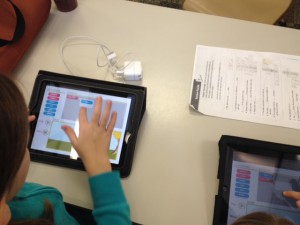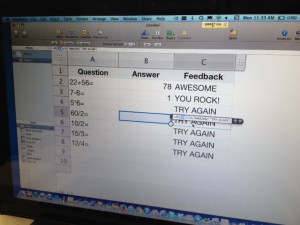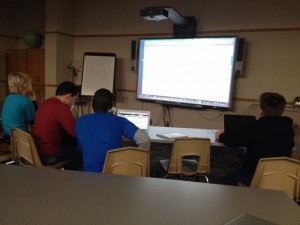This weekend I went to Kansas City with my 10 and 6-year-old to attend a Coder Dojo. It was really neat to see kids of all ages actively engaged in programming! Needless to say, I’ve been on a programming kick all day!
First graders started out using Daisy the Dinosaur on the iPad and learned how to use simple commands like move, jump, and spin to make Daisy the Dino complete various challenges. This app is free in the iTunes store and can be downloaded here: https://itunes.apple.com/us/app/daisy-the-dinosaur/id490514278?mt=8
 Hopscotch is another free app. You can download it here: https://itunes.apple.com/us/app/hopscotch-coding-for-kids/id617098629?mt=8 Here’s a quick video clip: 1stGradeProgramming
Hopscotch is another free app. You can download it here: https://itunes.apple.com/us/app/hopscotch-coding-for-kids/id617098629?mt=8 Here’s a quick video clip: 1stGradeProgramming
The 4th and 6th grade students learned some basic if/then programming using spreadsheets. See if you can understand what this means:
=IF(B2=72,”Awesome”,”Try Again”) Translation: If what you type in cell B2 is 78, then print “Awesome!” Otherwise, print “Try Again.” The students had fun making up problems and then testing their programming skills using a spreadsheet.
Translation: If what you type in cell B2 is 78, then print “Awesome!” Otherwise, print “Try Again.” The students had fun making up problems and then testing their programming skills using a spreadsheet.
Next, a 5th grader led a group of students in programming polygons using Java Script. He used Khan Academy and did a nice job explaining each step and having the students write notes in their notebook. These students will take turns teaching each other throughout the coming weeks.
 In the Did You Know 3.0 video, it talks about preparing students for a future filled with jobs that do not currently exist, using technologies that haven’t been invented, in order to solve problems we don’t even know are problems yet. In his TEDx Talk, Mitch Resnick talks about young people today having lots of experience and lots of familiarity with interacting with new technologies, but a lot less so of creating new technologies and expressing themselves with new technologies. I believe teaching kids to code is just one way to provide students with authentic and engaging problems while teaching them to communicate, problem solve, and persevere.
In the Did You Know 3.0 video, it talks about preparing students for a future filled with jobs that do not currently exist, using technologies that haven’t been invented, in order to solve problems we don’t even know are problems yet. In his TEDx Talk, Mitch Resnick talks about young people today having lots of experience and lots of familiarity with interacting with new technologies, but a lot less so of creating new technologies and expressing themselves with new technologies. I believe teaching kids to code is just one way to provide students with authentic and engaging problems while teaching them to communicate, problem solve, and persevere.
What are your thoughts about teaching kids to code? Leave us a comment!
So excited to see students passionate about their learning at Westgate! Glad to call this school my home and excited to share these type of opportunities with other Westgate students!
I think it is great for kids to be learning code. I think coding should be in every school.It seems like a fun and new way to solve problems.
Mrs. Spady,
We’re so glad to see you bringing coding to the classroom. Not only does programming sharpen problem solving abilities, but it also provides students with a firm base in understanding logic – two skills that will take them far in an increasingly dynamic world.
If there is one thing that has been absent from programming in the past (when I was learning to code), it was having truly tangible results. This is where the decreasing price of entry for people to work with robotics, and automation in general, come it. Being able to see a phyiscal device carry out the logic and commands that you prgram is a huge step forward from the terminal screen flashing “Hello World!”
Here are a couple of Tech Republic arcitcles I’ve recently received that touch on the increasing relevance of computer science in K-12 education.
Coding as a Second Language?
Kiddie Coders
These articles are great-thanks so much for sharing! I agree that having a physical device carry out the commands you program it to do or having an object on the screen respond to your commands is a huge motivator!